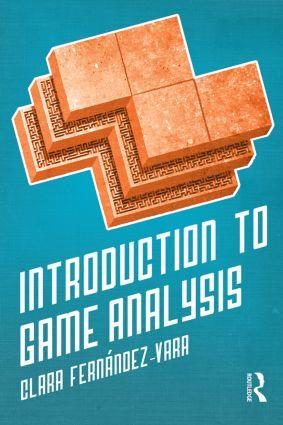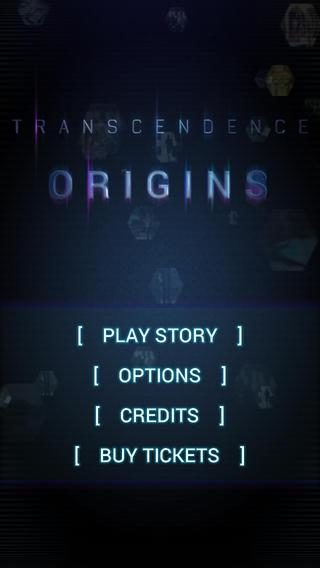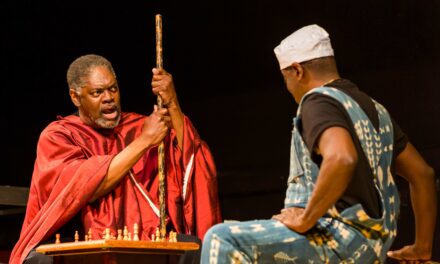Clara Fernandez-Vara is an Associate Arts Professor at New York University. Her background is in literature and performance studies, but she quickly began looking at how text can change meaning when it is enacted and how action or actors or context can change the storytelling in action. Once she stumbled upon a gothic story that made her realize that there were patterns in stories from the nineteenth century that felt like a video game. This is how she began looking at video-game playing as a type of performance and she also began making video games. She obtained her PhD at the Georgia Institute of Technology and was a postdoctoral researcher in the Comparative Media Studies department at MIT.
Á. Bakk: I read in the foreword of your book Introduction To Game Analysis that you consider games as a medium that only takes place when “communication takes place as a constant cycle of players making sense of the game, figuring out what they want to do, and seeing what happens.” How would you define the similarities between performance art and video games? Do they have the same features, since they belong to the same medium?
 C. Fernandez-Vara: I think that the way we would maybe extend how the performing arts also include interactive media and digital media, in general, is because of the need for a different kind of literacy, that is not only understanding what you are watching but also understanding how you are participating in that environment. A lot of this was inspired by Janet Murray’s work: she also talks about digital participatory environments. This also shapes the performing arts a bit: the performer and the audience are together, but the role of the creator is more about facilitating and giving tools for performing. We can also create games that are very specific: they talk about what they want the player to do, almost like improvised theatre. So what people do in Minecraft is that they are in an environment, they have cues about what they want to do, they can be farmers, they can mine, they can build houses, etc. All these are verbs and dramatic actions that we are facilitating through game design.
C. Fernandez-Vara: I think that the way we would maybe extend how the performing arts also include interactive media and digital media, in general, is because of the need for a different kind of literacy, that is not only understanding what you are watching but also understanding how you are participating in that environment. A lot of this was inspired by Janet Murray’s work: she also talks about digital participatory environments. This also shapes the performing arts a bit: the performer and the audience are together, but the role of the creator is more about facilitating and giving tools for performing. We can also create games that are very specific: they talk about what they want the player to do, almost like improvised theatre. So what people do in Minecraft is that they are in an environment, they have cues about what they want to do, they can be farmers, they can mine, they can build houses, etc. All these are verbs and dramatic actions that we are facilitating through game design.
Á. Bakk: This could be more applicable to immersive theatre. What do you think about walking simulators–how can they engage their players to really walk along?
C. Fernandez-Vara: I’m one of the defenders of walking simulators because their art is not something new. As one of the first creators in the genre, Dan Pinchbeck, was saying: What if we take a first-person-shooter engine and we make a game that is not about shooting? (not that shooting is required of these games). What if we can explore the space in the first person? For those of us who do enjoy that genre, the motivation to play these games is to figure out the story; this way we become a type of detective. If we want to provide players the motivation to explore the space, we can borrow devices from theatre: for example, by having interesting objects that might seem to work in a specific way. There is a lot that we can borrow from theme parks too. They are designed to encourage navigation in specific ways: good theme parks and good architectural design give you a sense of depth that makes you want to go further. The fun of these games is putting the story together: the story becomes a puzzle that you have to assemble through your navigation. There is more than just walking. It is hard to make a game about just exploring the space, because it does require a lot of set design. Architectural design is a given point; it’s telling stories through things rather than people, so there are many things that you can also include in a way to make the world feel deeper, for example, when you try to orient yourself. A lot of the stories are told in absentia; they have no characters, because modeling and animating characters is expensive. You tell their stories through their objects. But in dramaturgy and in creative writing we were always told that characters drive the story. But how do you tell this story without them being there for technical reasons? You can have voice-over, you can have dialogue, you can have the text, but also there are objects and props that become storytelling devices in a way that cinema uses props; in theatre, they are more part of the dramatic action–this is also very similar to walking simulators. They are the leftover objects which are going to tell the story that is prompting the player to interpret the space. It is not something completely new, but it is a scale that dramaturgs in new media need to develop in a way we haven’t seen before.
Á. Bakk: What are the boundaries of a narrative space? What is it that you can’t tell by using narrative space?
C. Fernandez-Vara: One thing that is trickier to do through space is creating dramatic urgency: you can create a certain pacing, through designing the navigation; you can tell and distribute the story by designing the levels in a specific way. Again, this is very similar to how architects design the flow within a building. One thing that theatre does that actors can also provide is dramatic urgency: seeing the body of the actor going through conflict. What comes second hand through the space is that we are not getting that kind of sense of vividness: it is similar to the difference between indirect and direct speech. Also, similarly, it applies to vividness: when we see violence onstage and bodies getting hurt, there is something that hurts us too. In other forms of games, because of their nature, the repetitiveness can also lose impact. This took me to one of the things that I have been working on in the last year: I had the chance to work with Ken Perlin and to use his Holojam system to work on theatrical experiments: we actually worked on a short play based on Alice In Wonderland. What the Holojam does is create a virtual reality space with multiple users, and we can have an audience and an actor in VR live but without having cables, etc. We had live actors and we could only track their head and hands. They were kind of puppeteering their avatars, and their movement lent them this liveliness. We also took some advantage of the VR environment: changing sets, changing costumes, changing size. But even in this case, the vividness of the actors could help us kind of cover up the system’s problems. When things broke down, the actors were improvising in ways that if you do not have a live actor, you cannot really do. This is an example of how having an actor, a body, does lend that kind of vividness that we have while watching a play, but we do not have that in games. In games when we see a character, we see “this is me.” In theatre we would say “our little puppet,” but in video games, we say “I’m Mario.” All these things are kind of the new ways of embodiment. This way we are players and performers, and part of our performances is embodiment.
I have been to Punchdrunk’s Sleep No More three times; I know that play very well. I find it very interesting, as I haven’t been to a lot of immersive theatre experiences, but I realized that actually, immersive theatre can learn a lot from video games. I love Sleep No More, but as a game designer I don’t think it is a game; it’s more like a theme park. Also, coming from theatre, I think immersive theatre can learn from game design things that don’t seem to be obvious. Immersive theatre looks like they are participating because they are in the space and they are navigating. Immersive theatre now gives the audience the impression that they are participants in the action, but they actually can’t be a participant.
 Á. Bakk: Can you list what immersive theatre could learn from video game design?
Á. Bakk: Can you list what immersive theatre could learn from video game design?
C. Fernandez-Vara: When you design it is not like when you are writing a play for the actors, but more like for actors trained to improvise within certain guidelines. To program non-player characters as a game designer, I have to program what the character does when I’m not there. Of course, actors are way better at improvising than digital actors, but then that is a frame of mind that is already part of my job. When you write immersive theatre, you have to think about the props and the objects, and how people are going to interact with the objects, what clues they will offer, what the audience will do with the objects. This is also similar to how, in an escape-room game, players have to be told that they cannot really remove the furniture. When you are making an object, it has behaviors, and you have to anticipate what people are going to do. It is all about that frame of mind, which the dramaturg can find challenging.
Á. Bakk: So you have to anticipate how the participant is going to behave with that object.
C. Fernandez-Vara: Yes, that is game design. Anticipating people’s behavior, what they are implied to do and how you get them to do what you want them to do or how you prevent them from doing what you don’t want them to do. What kinds of tools you are giving the audience to interact with the space or with the actors: this is game design. What I’m teaching my students right now is how to write text adventure games (also known as interactive fiction): how to create objects and characters, what their possibilities, affordances, are. This is kind of an accessible way to get people into the right frame of mind. But making this kind of game, on the one hand, is good training for making other genres. On the other hand, it is also the frame of mind that the immersive theatre dramaturg needs. You work with your text but you also make environments: you are creating characters that have behaviors and responses. Even though all the representation is textual, you still have dramatic action; you are typing and you are doing things in this world. That is one of the things I believe would be very useful for people working in immersive theatre.
Á. Bakk: What do you think VR experiences could learn from immersive theatre?
C. Fernandez-Vara: For me, the best pieces of VR film were the ones that were inviting me to look around and giving me clues about where to look. In film, there is the concept of editing within the frame: that means that the camera is looking where there would be a cut but it is just following the gaze. In VR there are ways you can guide the player to look. Immersive theatre and VR are very similar to these challenges. This is recurring in VR filmmakers; they struggle with “how do I get the people to look where I want them to look?” When coming from games, especially from 3D games, there is level design, architectural design; there is composition of the space, sound. When I was in theatre we didn’t really do a good job with sound. You don’t have take people by the hand; you can give clues through composition; you can show dramatic action to tell them where to go or where to look. If they don’t do what you want them to do, it is ok; what else are you offering your spectator? This is what, for example, Sleep No More does very interestingly. If you don’t follow the actors, you can also explore a very interesting world. There are game designers that are very controlling: they want you to play their games in a very specific way, and if you can’t play it like that, you’re playing it “wrong.” Some of us are just giving cues, inviting players to interact: I don’t want the player to do things that will not be interesting, satisfying, and challenging or that are boring. But I want them to have the room to do the things they want to do. Visual artists can be a bit more loose; in video games, we design the game and then we play-test it with people. If they do things we like, we leave it; if they don’t play the game as we would like them to, we change the game. For visual artists, it is different; they leave the spectator to interpret. I think that is also part of the nature of games and digital media, because in the participatory performance your spectator is also your player and part of your creative process.
The concept of immersive theatre goes against Brecht’s concept of Verfremdungseffekt: it is about making the spectator forget that we are in a play. In terms of politics, Brecht talks very clearly: he thinks that we consider this illusory medium to be real, and he is constantly reminding us that this is mediated. There are methods from Brechtian theatre that have parallels in how we create games: for example iteration. Before we program anything, we start with paper, and we put it in front of people and they have to imagine that the thing they have in front of them is a digital game, so those parts of the process are almost like drafts–it is a Brechtian workshop method. When Janet Murray talks about digital media being immersive, it is also part of an aesthetic; but all she talks about is how do we create a fiction, how do we create the suspension of disbelief. There is a possibility for games to learn from theatre and how to remind players about the medium’s artificiality: it is not all about losing yourself in the game. The best immersive theatre has very good mechanisms of entering and exiting, whereas VR doesn’t do this well at all. VR is terrible at that: you just get in and then you get out. The users feel it: there is motion sickness; but also quitting a VR experience and re-entering the real world can be shocking. Also, many traditional video games have a clear convention whereas virtual reality has no such thing, and this is one of the big problems of VR.
This post was written by the author in their personal capacity.The opinions expressed in this article are the author’s own and do not reflect the view of The Theatre Times, their staff or collaborators.
This post was written by Ágnes Bakk.
The views expressed here belong to the author and do not necessarily reflect our views and opinions.


















